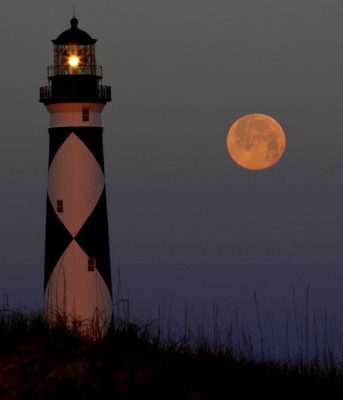“Maybe the wolf is in love with the moon, and each month it cries for a love, that it will never reach.”
Tiffani Zbikowski
Ever since humans have walked this earth, they have looked up into the night sky, in reverence and perplexity, at the stars, planets and also the moon. The silvery moon shines bright like a star, yet it doesn’t create its own light. It must give thanks to the sun for its radiant glow by reflecting light off of its sun-kissed face. This big hunk of rock is also denied the status of a planet since it orbits the Earth and not the sun.
The moon is, well, a moon, one of several (around 146) in our solar system. As the moon rises this Sunday, it will have so much going on that it may appear to be just showing off. Not only is it going to be full, but it will be super full, and it will also bring along an animal friend to be a full super wolf moon. Then, as it arcs across the celestial sky, it will perform a magic trick with a lunar eclipse. But wait; to bring more drama to this event, there will be blood. So, you will not want to miss out on this full super wolf blood lunar eclipse moon.
Supporter Spotlight
I’ll be out there looking, excited, waiting for the performance. I love the full moon and each month my inner werewolf takes me outside to watch it rise. Like an actor stepping onto a stage, the moon calls for your attention as it enters the horizon and begins to project its soft, warm glow. With all the sensationalism about Luna this month, lets breakdown what is really going on.
Every month we have a full moon as it orbits the Earth. The amount of sunlight on the face of the moon will slowly grow in phases due to the position of the moon to the sun as it orbits Earth. When the Earth is between the moon and the sun, the moon is tilted enough in its orbit for sunlight to completely illuminate the moon.
During a full moon, the moon is either above or below the shadow of the Earth. When the moon is directly between the sun and Earth, the face of the moon as seen from Earth does not receive any sunlight causing a dark or “new” moon.
Now what is so super about a supermoon? The term “supermoon” is a relatively new term that refers to when the moon is closest to the Earth during its monthly orbit and is also a full moon. Astronomically, this is called “perigee syzygy.” Since the moon is closer to Earth, it can appear to be bigger and brighter, thus, “super,” as compared to when it is farthest away from the Earth during its orbit. Some comparisons claim that the moon can look 30 percent brighter and 14 percent bigger. The size of the moon will look most exaggerated when it is just above the horizon and over an object such as a building. As it rises higher in the sky, it will appear more in size to what we always see.
Native American tribes, as well as other cultures, created names for each full moon that celebrated nature and the seasonal changes. During a time when wolves were much more numerous, their howl would punctuate the cold January air. Howling is a form of communication to locate pack members, intimidate rival packs and most importantly, locate a mate. Wolf breeding season starts in January and their howling becomes more urgent and obvious, leading to the January moon being called the “wolf moon.” At the Alligator River National Wildlife Refuge in eastern North Carolina, the opportunity to experience a real wolf moon still exists. The refuge is home to a small wild population of the endangered red wolf.
Supporter Spotlight

Emerging cultures throughout the world tried to make sense of celestial events, such as a lunar eclipse. The moon in particular invoked wonder but it also could summon fear. Stories, which became legends, were created to explain such unusual happenings.
The Inca of South America told the story of a giant jaguar that ate the moon. The Cherokee also have a legend about a hungry frog that swallows the moon. Some of the myths also try to rationalize why the moon turns a reddish, or “blood,” color during the eclipse. Natives of Brazil, the Ge, tell the story of the moon and sun fighting when a boy shoots the moon with an arrow, causing it to bleed red as its light slowly fades. A shaman then treats the wound and the moon recovers.
These imaginative stories are quite entertaining, but what is really happening is just as fascinating. A total eclipse of the moon occurs only during a full moon when the Earth is between the moon and sun. The moon, Earth and sun must be in alignment so that the moon passes through the shadow of the Earth created by the sun. This happens when the orbital path of both the moon and Earth meet during a full moon. The crimson color is caused by sunlight being refracted around and through the Earth’s atmosphere. Some colors are filtered out but the red and orange shades pass through and onto the surface of the moon.
The moon is a powerful presence in our lives, often without us even realizing it or at least taking it for granted. Here on the coast, it is most evident in the ebb and flow of the tides and must be contemplated by those that work, and play, on the water. The moon is thought by many to influence unsettling human behavior giving rise to the term “lunatic.” It features prominently in literature and song. The moon-infatuated poet William Wordsworth was definitely under its spell when he wrote “Strange Fits of Passion I Have Known.” And I can’t help but remember a popular song during my teenage years, “Dancing in the Moonlight,” by King Harvest.
The moon has inspired wonder and fear throughout the ages. So go outside and watch it glide into the sky, it will make you wonder but you have nothing to fear. Let’s hope for clear skies.
Jan. 20 Full Moon Timeline
- Moonrise: 5:02 p.m.
- Total Eclipse Begins: 11:41 p.m.
- Middle of Totality: 12:12 a.m.
- Total Eclipse Ends: 12:44 a.m.
Coastal Full Moon Events:
- Hammocks Beach State Park-Lunar Eclipse Night Hike
- Swansboro Super Moon Boat Cruise
- Cape Lookout National Seashore-Lunar Eclipse Viewing










